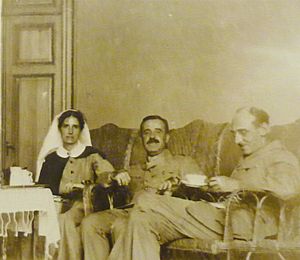Charles James Martin (physiologist) facts for kids
Quick facts for kids
Charles Martin
|
|
|---|---|
 |
|
| Born |
Charles James Martin
9 January 1866 |
| Died | 15 February 1955 (aged 89) |
| Awards |
|
| Scientific career | |
| Institutions |
|
Sir Charles James Martin CMG FRS FRCS (9 January 1866 – 15 February 1955) was a British scientist who did seminal work on a very wide range of topics including snake toxins, control of body temperature, plague and the way it was spread, dysentery, typhoid and paratyphoid, nutrition and vitamin deficiencies, proteins, and myxomatosis as a means of controlling rabbit populations. He was a director of the Lister Institute of Preventive Medicine, serving from 1903 to 1930.
Early life
Born in Wilmot House, Dalston, Hackney, North London he was the twelfth child of Josiah (an insurance company actuary) and Elizabeth Mary Martin (née Lewis), Charles James was part of an extended family of children from his parents' previous marriages. Being a delicate child, he was sent off to a private boarding school in Hastings.
At 15 he was employed as a junior clerk at the insurance firm where his father worked. He studied mathematics as a requirement for a future as actuary, but showed no special aptitude. Browsing through the numerous bookshops in the area, he came across a secondhand copy of "A Hundred Experiments in Chemistry for One Shilling." Carrying out these experiments, he was sufficiently inspired to entreat his father to allow him to pursue a career in science. He accordingly took evening classes at King's College, London. He then studied medicine at St Thomas's Hospital and spent some time in Leipzig studying physiology under Karl Ludwig.
Career
In 1891 he accepted a post as lecturer at Sydney University, before moving to the University of Melbourne as acting Professor of Physiology. He remained in Australia for 12 years, after which he returned to the UK to become the first Director of the Lister Institute of Preventive Medicine.
He was elected a Fellow of the Royal Society in 1901. His candidacy citation read:
Professor of Physiology in the University of Melbourne. Is eminently distinguished as an original investigator in Physiology. His chief original papers deal with the Chemistry and Physiology Action of Snake Venom, and with the action and reaction of Toxins and Antitoxins. Author of: – 'The Chemistry of the Venom of the Australian Black Snake' (Proc Roy Soc, NSW, 1892); 'The Physiology Action of the Venom of the Australian Black Snake' (ibid, 1895); Curative Action of Calmette's Serum against Australian Snakes' (Internat Med Journ, 1897–1898, and Proc Roy Soc, 1898); 'Nature of the Antagonism between Toxins and Antitoxins' (ibid, 1898, joint Author); 'Separation of Colloids and Crystalloids by Filtration' (Journ of Physiology, 1896); 'Observations on the Anatomy of the Muzzel of 'Ornithorhynchus',' with Dr Wilson (Linn Soc, NSW, 1892); 'Observations on the Femoral Gland of 'Ornithorhynchus',' with Dr Tidswell (Linn Soc, NSW, 1894); 'An Investigation into the Effects of the Darling Pea, 'Swainsonia galegifolia' (Agricultural Department of NSW); 'Cerebral Localization in Platypus' (Journ of Physiol, 1899)'
During World War I he served with the Australian Army Medical Corps in Gallipoli, Egypt, and France as a pathologist with the rank of Lieutenant-colonel. He found some cases of enteric fever at Gallipoli were not typhoid, but paratyphoids A and B, and made a vaccine for all three. A memo to his colleagues on the different treatments for amoebic and bacillary dysentery was widely circulated by the army under Martin’s name. In France he organized the integration of decentralized pathology services into the A.A.M.C. After the war he returned to the Lister Institute until his retirement in 1930. He then spent a further two years in Australia as head of the animal nutrition division of the Council of Scientific and Industrial Research in Adelaide. On his return to the UK he went to live at Roebuck House in Old Chesterton, Cambridge, which he equipped as a laboratory. During WWII it was used to rehouse the experimental animals being used for medical studies by the staff of the Lister Institute. In 1934 he undertook an experimental study of the myxoma virus, at Cambridge and on a rabbit-infested island in Pembrokeshire, to show it was both safe and effective to control plagues of rabbits.
He was awarded the Royal Society's Royal Medal in 1923 and delivered the Royal College of Physicians Croonian Lectures in 1930. He was knighted in 1927.
His contributions to the foundation of biological science in Australia were commemorated by the National Health and Medical Research Council, which created the Sir Charles James Martin Overseas Biomedical Fellowships in 1951.
Personal life
He died in 1955 at Old Chesterton. He had married Edith Cross, born 24 February 1860, died 2 March 1954, daughter of Alfred Cross in 1891. They had one daughter. He is buried in the Parish of the Ascension Burial Ground in Cambridge, with his wife.


